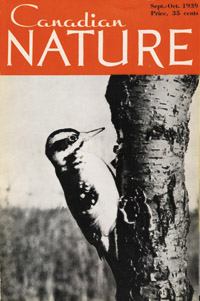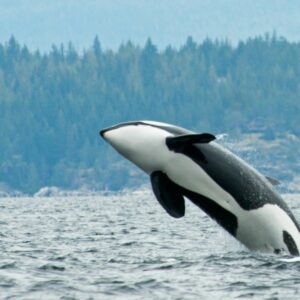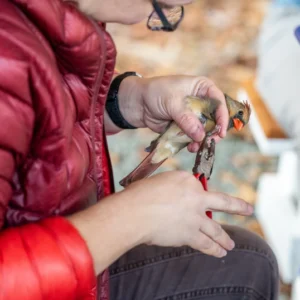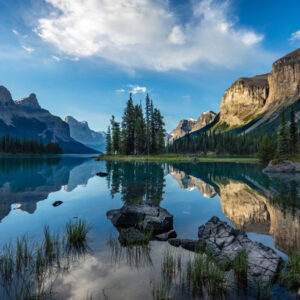From the Archives: Meet the first-ever guest on the cover of the original Nature Canada magazine, Canadian Nature
Across many cultures, if you spot a woodpecker, it is considered a good omen, symbolizing new possibilities, luck, resourcefulness and perseverance. In a few indigenous cultures, this bird is also known as a protector, a spiritual messenger, with its drumming believed to represent the heartbeat of the earth.
And if you happen to hear what sounds like a squeaky pet toy, rapid drumming on wood, together with a loud, sharp “peek” call, then you may be in the company of the somewhat soldierly Hairy Woodpecker.

So who is this star bird that was chosen to be featured in the magazine?
First of all, despite its name, it is actually fully covered in feathers, with some fluffier bits of white that may look a bit like hair. The first scientific description of this Hairy Woodpecker was written by the famed naturalist Carl Linnaeus in 1766. He coined the binomial name Picus villosus, and the specific epithet villosus is the Latin word for “hairy”.
These birds with their special powerful beaks that withstand all the drumming, are contrastingly black and white, with black wings checkered with white; and head donning two white stripes. The drumming on wood establishes territory and is used to communicate with other woodpeckers. Their musical courtship includes both birds drumming in duet and tapping at nest sites by females. The couple remain together for a whole year, and in some cases, for life.
These woodpeckers hitch up tree trunks and along main branches in search of insects, keeping insect populations under control. They also eat fruits, berries, seeds as well as tree sap. Known for their sweet tooth or rather beck, these birds can be lured into backyards with some suet dough, sugar water and fruits.
But for a far more colorful description of this very special feathery model that graced the cover of the iconic magazine, we go back to the original publication.
“Ages ago,” starts the light-hearted article that tells the story of this wonderful front cover photo, “a brood of spotted woodpeckers had some differences of opinion. One (possibly more) decided to either grow and stay large or refuse to grow up altogether.”
“This may not be exactly true, but it gives some idea of why we see two sizes of the black and white spotted Woodpeckers. There is growing belief among scientists that these two species originated from some common ancestor, and having changed in size, for some reason or other, stayed that way.
These two species are called ‘Hairy’ and ‘Downy’ Woodpeckers, although clothed only in feathers as all other birds. The white stripe down the back is supposed to resemble hairs. The Hairy Woodpecker is the larger, being about nine inches long, and on that account any hirsute covering would be well past the ‘downy’ stage.
Besides a difference of three inches in size, the bill of the Hairy is proportionally longer and stouter, the call more in keeping with a larger bird, while there is also a difference in the marking of the outer tail-feathers.”
And the best part: “The Hairy is not quite as confident as the Downy, and is more apt to remain in larger woods, even in winter, although occasionally suet will tempt him about your garden. Males of both species have red napes.”
Since the cover photo is in black and white, it is difficult to see if there is an actual red nape patch around its head. If it is just a play of shadows, and there is no red nape, then it is a female Hairy Woodpecker, perhaps quite appropriately since this magazine was launched in honor of a very special lady.
Canadian Nature — upon which today’s Nature Canada is founded — was born on February 23rd, 1939, in memory of Mabel Frances Whittemore, who passed away on this date.
“Her love of nature and understanding friendship for children are the inspiration for its publication,” wrote her husband, A.R. Whittemore, the publisher.
“It is our earnest purpose to make this magazine a fitting tribute to those qualities of heart and mind which imbued her desire to share with others the joy of interest in nature.”
This interest, this love and care for nature, is at the heart of Nature Canada, a true testament to the original founding stone, as best captured in the published words of Mrs. Whittemore’s herself.
“It has always puzzled me that so many people live in the midst of the fascinating, amazing, and almost unbelievable things such as we find in the world of nature, yet are almost unaware of them. There is so much beauty in our immediate surroundings of which are not conscious.
My curiosity concerning what we term our commonplace surroundings has led to much enrichment of interest and has put so much thrill and adventure into the most ordinary outings, that I have felt real concern for those who seemed to be missing the fun. This delight in the interesting things around us is apparently shared by members of my family, for my young daughter quite innocently remarked one day, “Mother, what do people do for fun who aren’t interested in Nature Study.”
It has seemed extremely important that children should discover what an interesting world we are living in — interesting in ways that have nothing to do with money or artificial stimulation.”
And Mr. Whittemore concludes this page with: “With this objective – Canadian Nature will carry on.”
We are privileged to be able to go back in time, and read these words from the surviving copies of the Canadian Nature magazine. It was introduced to the world then as “a bi-monthly magazine devoted to nature and its conservation. It advocates wholesome living and right thinking.”
Looking at the magazine’s table of contents, one is at awe at how ahead of its time it was in terms of the environment, conservation and appreciation of nature.
Spanning over 60 pages, it included articles on more birds (like hawks and ducks), botany, children’s nature story, geology, insects, mammals, nature walks, shells, trees, schools and museums, how to build an aquarium for fish and amphibians and more. Truly a wide range of interesting topics that capture the diversity and beauty of nature.
While it was never explicitly explained why the Hairy Woodpecker was chosen for the cover, it is symbolic of a determined bird whose drumming still strongly echoes today in Canadian forests.
This particular Hairy Woodpecker, a resident non-migratory bird of North America, including Canada, is not on any endangered lists, but this species has been identified as a priority for conservation and/or stewardship in one or more Bird Conservation Region Strategies in Canada.
But it and other birds in Canada need our help to keep them safe. One of the latest Nature Canada initiatives is Save Bird Lives. To help protect Canada’s birds from disappearing from your yards, our parks and our lives, see here how you can take action.



